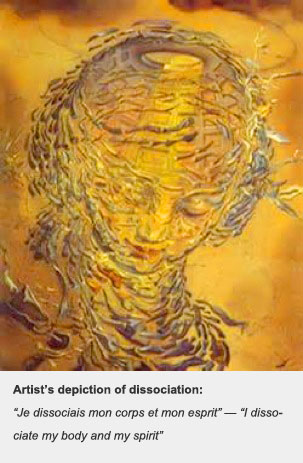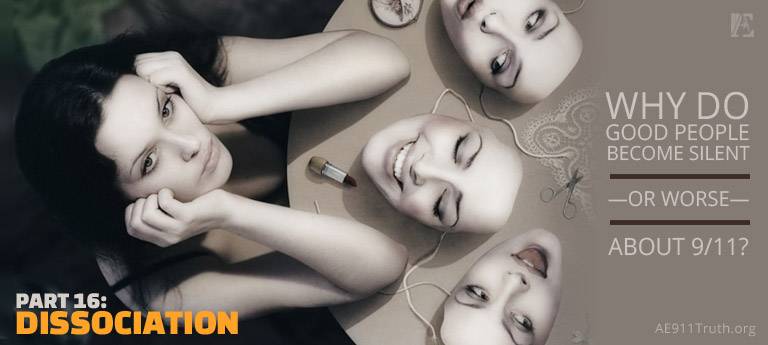When such a vulnerable person hears the evidence that 9/11 skeptics present, he . . . may become silent and unresponsive as though disoriented, so that he appears "spacey."
Part 16: Dissociation
By Frances T. Shure
Editor's Note: Frances Shure, M.A., L.P.C., has performed an in-depth analysis addressing a key issue of our time: "Why Do Good People Become Silent — or Worse — About 9/11?" The resulting essay, being presented here as a series, is a synthesis of both academic research and clinical observations.
© by Frances T. Shure, 2015
 In answering the question in the title of this essay, the March 2015 segment — Part 15: The Abuse Syndrome — explored how the “nothing we can do about it” reaction to hearing the evidence that refutes the official account of 9/11 may be a result of toxic early relationships — often characterized by trauma bonding — which bring about feelings of powerlessness, shame, or apathy in adulthood.
In answering the question in the title of this essay, the March 2015 segment — Part 15: The Abuse Syndrome — explored how the “nothing we can do about it” reaction to hearing the evidence that refutes the official account of 9/11 may be a result of toxic early relationships — often characterized by trauma bonding — which bring about feelings of powerlessness, shame, or apathy in adulthood.
Here, in the April 2015 installment, we continue Ms. Shure's analysis with Part 16: Dissociation.
DISCLAIMER: Architects & Engineers for 9/11 Truth is dedicated to researching and disseminating scientific information about the destruction of three World Trade Center skyscrapers on September 11, 2001, and does not speculate as to the identity or motives of the perpetrators. In this series of articles, any reference to names or motives of the attackers, made by either the author or the individuals she quotes, is a personal opinion and not the view of AE911Truth.
Dissociation is a psychological defense mechanism that occurs on a continuum, ranging from mild detachment, which we all experience from time to time, to the most extreme form, known as Dissociative Identity Disorder. The latter, DID for short, was formerly known as Multiple Personality Disorder. DID is a coping mechanism for the victim of torturous, repetitive abuse — usually endured at a very young age. To protect himself from the unbearable pain of such torture, the victim may fragment into two or more distinct identities, with each identity, or personality, taking control over the individual at various times.1
 In the middle of this wide continuum is a severe and, unfortunately, all too common level of dissociation that, in common with DID, also originates in trauma that is usually incurred at an early age. What differentiates the mid-range level of dissociation from learned helplessness and from the abuse syndrome, which are related in that they are also trauma-initiated, is that the adult victims of this form of early trauma do not react to abuse or to challenging information — such as the evidence presented by 9/11 skeptics — with powerlessness, shame, or apathy. Instead, they automatically defend themselves by biologically shutting down their awareness to the point of becoming emotionally detached at the very time when expressing emotion would be considered a more normal response to the situation.
In the middle of this wide continuum is a severe and, unfortunately, all too common level of dissociation that, in common with DID, also originates in trauma that is usually incurred at an early age. What differentiates the mid-range level of dissociation from learned helplessness and from the abuse syndrome, which are related in that they are also trauma-initiated, is that the adult victims of this form of early trauma do not react to abuse or to challenging information — such as the evidence presented by 9/11 skeptics — with powerlessness, shame, or apathy. Instead, they automatically defend themselves by biologically shutting down their awareness to the point of becoming emotionally detached at the very time when expressing emotion would be considered a more normal response to the situation.
Clearly, dissociation psychologically protects a person who has been traumatized by abuse incurred in infancy or childhood from the full brunt of the shock. Equally clearly, the victim of abuse at such an early age is especially vulnerable and helpless. Unable either to fight back or flee, he defends himself by emotionally freezing and dissociating himself from the abuse. In these severely traumatic situations, which are at the very least profound betrayals, if not actual torture, the young victim reflexively shifts awareness away from the dangerous situation — sexual or physical abuse by a parent, for example — as well as away from his emotional reaction to this danger. Therefore, the event and the person’s reaction to the shocking situation become repressed, a part of the individual’s unconscious mind.2
If someone who was subjected to such childhood abuse hears evidence that suggests that the “parental figures” in the government may have committed — or at least wittingly permitted — the mass murder of fellow countrymen, such shocking news can easily activate that person's memory of an early shock or trauma, when his parents or other adult authority figures endangered his safety or survival.
When such a vulnerable person hears the evidence that 9/11 skeptics present, he may react with a sudden bulging or glazing of his eyes, or the blood may drain from his face, or he may become silent and unresponsive as though disoriented, so that he appears “spacey.”3 These physiological signs are indications that the memory of an early, shocking, repressed event has been activated, and the person is again dissociating. Understandably, most victims with this condition assiduously avoid 9/11 truth-tellers and their fact-based and forensic information.
In next month’s essay, we shall look at a group of people who have a very different psychodynamic: Instead of avoiding 9/11 Truth, they may become enraged by the mere mention of it, due to their excessive identification with the United States of America.
Editor's note: To be continued in the next issue with Part 17: The False Self and Excessive Identification with the U.S.A. Electronic sources in the footnotes have been archived. If they can no longer be found by a search on the Internet, readers desiring a copy may contact Frances Shure for a copy here.
Continued with Part 17: The False Self and Excessive Identification with the U.S.A.
2 Janae B.Weinhold and Barry K. Weinhold, Healing Developmental Trauma: A Systems Approach to Counseling Individuals, Couples, & Families (Love Publishing Company, 2011), 154–156. The Weinholds see developmental trauma on a continuum that differentiates among stress, trauma, and shock. Of the three, shock is the most debilitating form of developmental trauma and underlies the psychological defense of dissociation.
3 Janae and Barry Weinhold, Healing Developmental Trauma, 148.






